
5/5/2003 I awoke early at the Ramada Inn, with no alarm, in time to take the first Amtrak Hiawatha to Chicago and officially be on my way home. I showered and packed before checking out and walking back to Amtrak on a very foggy dripping morning.
Hiawatha Service 330 5/5/2003At 6:02 AM, the conductor opened the door and turned the passengers loose on the train. Our consist was NPCU 90222, Horizon coaches 54531 (green seats), 54527 and 54504 (red), 54525 (green) and P42DC 139 and we proceeded south through the heavy morning rain with my day's plans changing as we sped along. We made our way to Sturtevant, where a good number of passengers were waiting under umbrellas and SOO Line 4443 was waiting for us to clear so he could get back to his work. Conductor Mussini made sure I knew about the Metropolitan Lounge in Chicago and that all my meals would be free so eat heartily.
We entered Illinois then pounded over the Elgin, Joliet and Eastern diamond at Rondout and crossed over to make our next stop at Glenview before re-crossing at Morton Grove to resume our high-speed running. We paused at the Mayfair crossing where an former Chicago and North Western train blocked our path while a CTA Blue Line train was in the expressway below towards O'Hare International Airport. At the junction with Metra's Elgin Line, a long eastbound was waiting for us to clear. We stopped at Western Avenue due to congestion at the Chicago and North Western crossing there and the clouds had lifted, so I reverted back to the original plan of going to the Museum of Science and Industry. We arrived at Chicago Union Station five minutes early and I saw one of the new Metra locomotives being tested behind an F40C.
Chicago 5/5/2003
I stored my bags in the Metropolitan Lounge, went upstairs for hot cakes and sausage then I walked first to the Lake Street bridge for pictures before going to ground level at the Canal Street crossing, another excellent location for photography. Once I had my fill, I walked over to the CTA Green Line stop on Clinton and caught Train 616 to Garfield where I connected with the CTA X55 Garfield Express Bus to the front steps of the Museum of Science and Industry.
Museum of Science and Industry 5/5/2003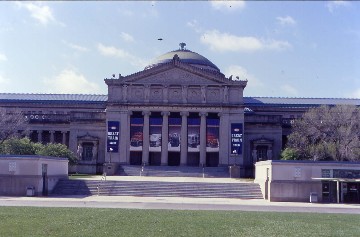
The Museum is housed in the Palace of Fine Arts from the 1893 World's Columbian Exposition. Initially endowed by Sears, Roebuck and Company president and philanthropist Julius Rosenwald and supported by the Commercial Club of Chicago, it opened in 1933 during the Century of Progress Exposition.
As the bus pulled up to the front, I noticed huge banners for "The Great Train Story" then descended into the Great Hall, where one could not fail to notice the Pioneer Zephyr on display. I paid my admission and made a beeline for the Zephyr.

In dimmed light is Chicago, Burlington and Quincy three-unit set 9900 "Pioneer Zephyr" built by Budd Company and Electro-Motive Corporation in 1934. It was the first of the CB&Q's fleet of Zephyrs, one of the largest and most famous fleets of streamliners in the United States. With the county then in the depths of the Great Depression, and both freight and passenger railroad revenues down, the fleet was conceived as a means of encouraging passengers back onto the rails. Originally christened the Zephyr, 9900 was built entirely of welded stainless steel. Aeronautical engineer Albert Gardner Dean designed the sloping nose, with architect John Harbeson and industrial designer Paul Philippe Cret devising a way to strengthen and beautify the sides of the train with its distinctive horizontal fluting.
The three cars rode on four roller-bearing trucks, forming a permanently articulated 197' long trainset weighing 193,000 lbs. The Zephyr's christening was on 18th April 1934, at the Pennsylvania Railroad's Broad Street Station in Philadelphia. On 26th May 1934, the train set out on a one thousand and fifteen mile non-stop "Dawn-to-Dusk" dash from Denver to Chicago, departing at 7.04 am Central Daylight Time and arrived in Chicago at 8.09 pm, thirteen hours and five minutes later, or one hour and fifty-five minutes faster than scheduled. It averaged 77 mph and, for one section, reached 112.5 mph, close to the then world land speed record of 113.6 mph. Reporters along the route referred to it as the "Silver Streak", running faster than any other train on American rails at the time.
From Chicago Union Station, the trainset went on display at the 1934 Century of Progress fair. After the fair, it started a thirty-one state, two hundred and twenty-two city publicity tour, during which more than two million people saw it. The Zephyr entered revenue service on 11th November 1934 between Kansas City, Omaha and Lincoln and by June 1935, had proved so popular that a fourth coach car, 525, was added to the trainset seating forty. It set new standards in passenger service and formed the model for other railroad's streamlined trains as well as the CB&Q's later Zephyrs.
The original Zephyr was renamed the Pioneer Zephyr in 1936 to distinguish it as the first of CBQ's growing Zephyr fleet. By 1955 ,the Pioneer Zephyr's route had been updated to run between Galesburg and Saint Joseph and its last revenue run was on 20th March 1960 from Lincoln to Galesburg. On 26th May 1960, it was presented to the museum, having run 3,222,898 miles in service.
My timing was perfect as a tour of the train was about to occur. We would board and go back in time to ride the record-breaking trip from Denver to Chicago in 1934 and we were taken into the baggage room and the train started moving, real motion added to stimulate the train going down the tracks. Next we walked into the express room where we met Zeph, the talking mule who told his story about the amazing run of the Zephyr. This was followed by sitting in the men's coach section, or smoking area in those days. Next we went into the regular coach section where mechanical passengers told us about their journey. Through the rear door, we went into the first class section getting to meet Mr. Budd of the CB&Q, along with his daughter and granddaughter, who through the use of video in the rounded rear-end observation windows, showed us views of the journey and arrival in Chicago, the Chicago Fair and fireworks.
I detrained, wondering since I just went from Denver to Chicago, could I count those miles? I toured the operating cab, engine room and Railway Post Office then my ride and tour of the Pioneer Zephyr was complete and I lived a part of history.
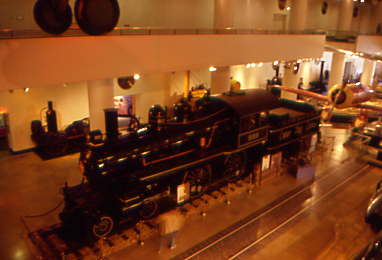
Museum of Science and Industry 4-4-0 999 1962, ex. New York Central Railroad 999 1923, exx. New York Central Railroad 1086, exxx. New York Central and Hudson River Railroad 1086 1913, nee New York Central and Hudson River Railroad 999 built by the railroad in 1893.
The New York Central & Hudson River Railroad's long running rivalry with the Pennsylvania Railroad over the New York-Chicago passenger service came to a head with the announcement of the World's Columbian Exposition in 1893. To steal a march on the Pennsy, the NYC unveiled this 4-4-0 designed by NYC&HR's chief Superintendent of Motive Power & Rolling Stock, William Buchanan. The boiler, smokestack and cylinders were finished in blue-grey Russia iron, the brass details, exposed pipes and edges polished, aluminium striping outlining each stave of the wooden cowcatcher, driver spokes and counter balances, the railroad's initials emblazoned on the tender's slope sheets, on the flanks of which in bold, aluminium leaf script was the name of the train it would haul, the Empire State Express.
999 entered service on 9th May 1893, hauling the Empire Express from Syracuse to Chicago, with Engineer Charles Hogan and Fireman Al Elliott at the controls. As the train neared East Buffalo, Hogan gave 999 its head. Slowly the speed rose until, at about milepost 423 just before the curve leading to Rochester, it was recorded by several people on board momentarily reaching 112.5 mph, theoretically making it the fastest moving man-made object of its time and the first on wheels to exceed 100 mph.
999 went on display for the duration of the Colombian Exposition described as the "Fastest Locomotive in the World". It then entered regular service on the Empire State Express, working the more level segment between Syracuse and Buffalo. Although tried on other parts of the system, 999 was found to be too slippery and hard to handle on trains exceeding five passenger cars. By the 1920's, 999 had been moved to the general passenger motive power pool along with all the other NYC 4-4-0s. In 1938, it appeared at the New York World's Fair and, in 1948-49, at the Chicago Railroad Fair. Shortly after, however, the NYC turned its back on steam motive power and the locomotive went into storage.
Rendered obsolete by techological advances in locomotive design and the eclipse of steam by diesel-electrics, in May 1952, following a re-enactment of its record breaking run, 999 was officially retired from service. The New York Central donated the steam engine to the Chicago Museum of Science and Industry in 1962, although it did not arrive until 1968 when it went on display outdoors. Following a complete restoration from June to October 1993, the locomotive was then brought inside to its present location in November 1993.
I next toured the rest of the museum seeing, of course, "The Great Train Story" and replicas of other steam engines including "The Rocket". The main part of the display is the huge model railroad featuring 34 trains racing along 14,000 feet of track on a cross-country trip from Chicago to Seattle. I then went through the rest of the museum, except the U-505 submarine, which I saved for another visit.
I returned via the 55 line CTA bus with a very friendly driver, then the Green Line train 605 back to Clinton and walked back to Union Station for a Char Dog lunch, a call home and to relax in the Metropolitan Lounge until train time. It is always interesting to watch passengers leaving to board their trains, such as the Empire Builder, which I wish I was going on, and the California Zephyr with a been there, just did that one before they called my train, the Southwest Chief to take me home to Southern California.
Southwest Chief 3 5/5/2003My walk to board was from the back door of the lounge down the whole length of the train, starting with the road railers forward to the first sleeper "South Dakota". I was greeted by Edward Clayton and went up to my room to prepare it for my journey. The eastbound Southwest Chief and California Zephyr both arrived here Chicago early today before our on-time departure. With our rear business already on the train, we proceeded to Naperville then out onto the Race Track for the Illinois countryside. Listening to John Cougar's "Scarecrow" and crossing all the farmlands with their small towns really struck me and later, took the Cameron cut-off to reach the former Santa Fe main line.
Dinner lasted from 6:30 PM until 8:45 PM and took place in three states, although I only ate in two. I had a mere roll in Illinois, nothing in Iowa and in Missouri had my order taken. By La Plata, my Delmonico steak arrived and I had a chocolate bundt cake for dessert well after dark. Our waitress, Jackie, worked half the dining car by herself with no help and she did not really know what she was doing. The steward finally assisted one table, but of course it was not mine. It was the most striking lack of teamwork that I had seen on an Amtrak dining car in all my miles. Some of my better jokes and stories helped pass the time and as I always say, "Every trip is an adventure!" Since the sun had set a long time ago, I returned to my room, knowing I did not have to face the sun blazing into my room, and enjoyed some Blue Oyster Cult into the night then went to bed after Marceline.
5/06/2003 I awoke to the sound of attendant bells ringing away, which meant God wanted me up at 5:55 AM CDT and I walked back to the lounge car, acquired a cup of tea and watched the Kansas landscape pass which made me think of Steve Walsh of Kansas's solo song, "Every Step Of The Way!" as lightning flashed off in the northwest. I went to the dining car as the Chief travelled through a squall line with lightning, heavy rains and some hail as I enjoyed a much quicker meal of French Toast. The couple sitting across from me were transported from Champaign to Chicago via a van, but had to pay for that as Amtrak did not provide an on-time bus for the City of New Orleans that had been delayed by the Tennessee tornados. After freshening up, we reached Lamar, Colorado.
We passed the John Martin Reservoir as we approached our servicing stop of La Junta, where everyone could detrain for forty-five minutes and I was able to recorded our consist which was: P42DCs 83, 196, 189 and 76, baggage 1246, transition 39021, sleepers 32109 "South Dakota" and 32027, diner 38034, lounge 33007, smoking coach 31503, coaches 34092 and 34057, Express box cars 71167, 71181 and 71195, ExpressTrak 74104, 74005, 74042 and 74049, Roadrailers 462073, 460253, 462147 462102, 462198, 462207, 460044 and 462079. I ran into Andee, a coach attendant, whom I knew from the San Diegans and it was always great to see her, then we departed on time.
The train sped across the high plains as Pikes Peak became cloud-free for just a few minutes then we paused briefly at Trinidad before we made a rather quick journey over Raton Pass into New Mexico, where we sat waiting on time. I was listening to Uriah Heep's "Live" as we made our way to Las Vegas, down to the Pecos River and up Glorieta Pass.
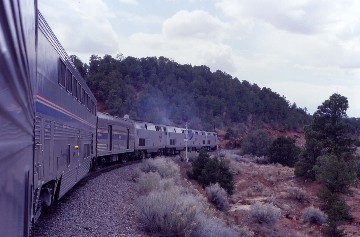
At Canyoncito we went into the siding and I went to the lounge car for the passage of the 17-car eastbound Southwest Chief, followed by our trip through Apache Canyon to Lamy and on into Albuquerque, where we had an hour and twenty- five minute layover. I walked to a store in town for a USA Today before calling home, then Trainweb, to learn that the Mighty Ducks of Anaheim had defeated the Dallas Stars as one cannot obtain a West Coast sports score due to the lateness of the game compared to when the newspaper has to be ready to go. I bought Karen, my wonderful Amtrak agent in Solana Beach, a blanket from one of the vendors at the station.
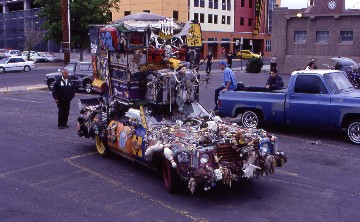
A "junk car" that had been seen on "Ripley's Believe It or Not". I caught up with Andee before going to my room to listen to Young Dubliners' "Alive, Alive" and read USA Today as the crew removed P42DC 196 from our consist so it could be used on Train 4 tomorrow.
We departed Albuquerque ten minutes late and with that I went to the dining car for another Delmonico steak and chocolate bundt cake and we sped west through Grants to the Continental Divide and into Gallup, chasing the sun west while I listened to the Scorpions' "World Wide Live". The sun set west of Gallup and the Chief proceeded into the Arizona night where I made up my bed and called it the last night of this trip.
5/7/2003 Up at 5:30 AM as the train was leaving Barstow, I went to the dining car, which was late in opening, and was met by a very rude Jackie, before I waited in the lounge car. I had only two choices, pancakes or eggs, so you know which one I took and managed to get the last sausage with my pancakes and had to remind Jackie about orange juice as the poor lady sitting across from me had nothing with which to wash down her meal. She and her husband were making a Chicago-Los Angeles-San Francisco-to-Chicago triangle. We climbed the east face of Cajon Pass before becoming stuck in a train traffic jam just east of Summit then finally descended down the three percent south track with trains all over the pass. It had to be one of the busiest Wednesdays I experienced here on this very overcast and gloomy morning.
We made our way to San Bernardino before travelling to Riverside and onto Fullerton, where I detrained a rested passenger, but one who was an hour and fifty-four minutes late. I went up to the Trainweb offices and found Ray Burns and Shivam Surve, briefly told them about my trip and checked my e-mail, then called home, asking my mother to be at the station at 9:23 when my train was scheduled to arrive. At least, that was the plan.
Pacific Surfliner 566 5/7/2003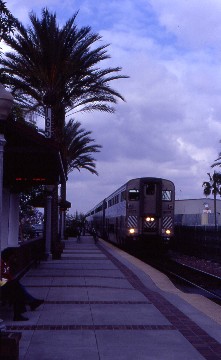
Train time came and went with no announcements and a call to Julie, Amtrak's automated agent, resulted in the news that it was eighteen minutes late at that point. It finally arrived thirty minutes later, with Conductor Rick Reyes greeting me and telling me of the door problems. It was a Surfliner set and we could not leave Fullerton until Rick had gone back to the engine to reset something to get us on our way. We made it through to Anaheim with no more door issues, then arrived at Santa Ana, where my mother had patiently waited for my late train. That brought another interesting Amtrak adventure to a close.
| RETURN TO THE MAIN PAGE |